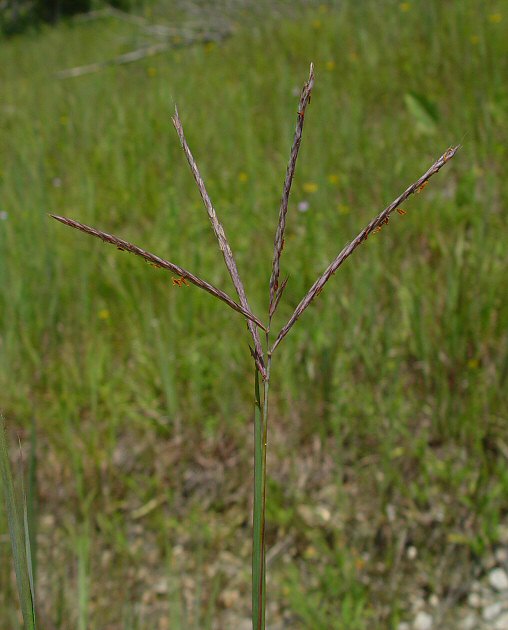Andropogon gerardi Vitman
Big Bluestem

Native
CC = 5
CW = 0
MOC = 83
© DETenaglia
Andropogon gerardi VitmanBig Bluestem | |
 |
Native CC = 5 CW = 0 MOC = 83 |
© DETenaglia |
|
Family - Poaceae/Andropogoneae Habit - Perennial grass. Stems - Erect, to 3 m, usually unbranched, circular in cross-section, glabrous, usually glaucous.
Leaves - Sheaths rounded on the back, glabrous or hairy, the uppermost sheaths not inflated, the ligule a short, stiff membrane with a hairy (fringed) margin. Leaf blades 8-50 cm long, 5-10 mm wide, glabrous or the lowermost ones hairy, especially near the base, relatively flat, the midvein noticeably thickened
Inflorescences - Palmate clusters of 2-4 spikelike racemes not enclosed by the subtending leaf sheaths, the racemes mostly 4-11 cm long, relatively stiff and straight, with a purplish brown coloration, the hairs on the joints of the axis and the spikelet stalks 1-4 mm long, white or yellow. Flowers - Stalked spikelets staminate, similar in size and appearance to the sessile, perfect spikelets (but awnless), the stalk about 1?2 as long as the sessile spikelet (excluding the awn). Glumes 6-11 mm long, narrowly ovate, usually somewhat roughened and often also glaucous. Lemmas with the body 5-9 mm long, the awn 8-19 mm long, spirally twisted and bent near the base. Anthers 2.5-4.0 mm long.
Flowering - June - September. Habitat - Prairies, glades, open rocky woods, railroads. Origin - Native to U.S. Other info. - This large species can be found throughout most of Missouri except for the extreme southeastern lowlands. This is a common grass in the habitats mentioned above. The blue glaucous coating on the stems and bluish color of the leaves give the plant its common name - "Big Bluestem." Photographs taken in the Ozark Scenic Riverways, Shannon County, MO., 8-29-03, and at the Sunklands Conservation Area, Shannon County, MO., 7-26-04. |